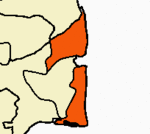
Thiruvavaduthurai Adheenam is a Saivite mutt based in the town of Thiruvavaduthurai in Kuthalam taluk of Mayiladuthurai District, Tamil Nadu, India.[1] The adheenam maintains the Mayuranathaswami temple at Mayiladuthurai.[citation needed] As of 1987, there were a total of 15 Shiva temples under the control of the adheenam.[2]
Key activities[edit]
The Adheenam is involved in publishing Saivite literature, specifically Thevaram and Tiruvasakam and its translations. It is also involved in literary scholarship. Some of the prominent Tamil literary personalities like Meenakshi Sundaram Pillai had their tutorship in the Adheenam. His disciple U V Swaminatha Iyer, who published many Tamil classical texts also was associated with the organization.[3] The Adheenam along with Thiruppanandal Adheenam and Dharmapuram Adheenam were founded during the 16th century to spread the ideology of Saiva Sidhantam.[4]
Notable events[edit]

In connection with India's Independence in August 14, 1947, two emissaries from the Adheenam presented Jawaharlal Nehru, a golden sceptre, referred to as "Sengol", at his home in Delhi in an elaborate ceremony.[5] Sengol, which is derived from Tamil word ‘semmai’, meaning righteousness, had an important place in Tamil culture; as when a new king was crowned, he would be presented with a ‘sengol’ during the coronation by the high priest and be reminded that he had the “aanai” (order or decree) to rule justly and fairly.[6][7] C. Rajagopalachari, who was also an ardent follower of this Adheenam, is often credited with the idea of the Sengol.[7]
On May 28, 2023, at the beginning of the inauguration of the new parliament, the Adheenam priests performed a traditional puja in which Prime Minister Narendra Modi participated, and Modi bowed down before the sacred Sengol as a mark of respect.[8] Then a group of Adheenam priests presented the Sengol to PM Modi, who installed it near the chair of the Speaker of the Lok Sabha in the new Parliament building.[9]
See also[edit]
References[edit]
- ^ Census of India, 1981: Tamil Nadu. Controller of Publications. 1962. p. 7.
- ^ M. Thangaraj (2003). Tamil Nadu: an unfinished task. SAGE. p. 170. ISBN 978-0-7619-9780-1.
- ^ M.M.M., Mahroof (1993). "Arabic-Tamil In South India And Sri Lanka: Language As Mimicry". Islamic Studies. 32 (2): 182. JSTOR 20840120.
- ^ Peterson, Indira V. (1982). "Singing of a Place: Pilgrimage as Metaphor and Motif in the Tēvāram Songs of the Tamil Śaivite Saints". Journal of the American Oriental Society. 102 (1): 82. doi:10.2307/601112. JSTOR 601112.
- ^ "INDIA: Oh Lovely Dawn". The Time.com. 25 August 1947. Retrieved 2023-06-06.
From Tanjore in south India came two emissaries of Sri Amblavana Desigar, head of a sannyasi order of Hindu ascetics. Sri Amblavana thought that Nehru, as first Indian head of a really Indian Government ought, like ancient Hindu kings, to receive the symbol of power and authority from Hindu holy men [...] One sannyasi carried a sceptre of gold, five feet long, two inches thick. He sprinkled Nehru with holy water from Tanjore and drew a streak in sacred ash across Nehru's forehead. Then he wrapped Nehru in the pithambaram and handed him the golden sceptre.
- ^ "The Sengol — A historic sceptre with a deep Tamil Nadu connection". The Hindu. 2023-05-24. Retrieved 2023-06-23.
- ^ a b "Manu S Pillai on Sengol: For some, rediscovery is cultural renascence, for others, political Hinduisation of a national symbol". The Indian Express. 2023-05-28. Retrieved 2023-06-06.
- ^ "PM Modi installs historic sengol in lok-sabha, prostrates before it as mark of respect". Jagran English. 2023-05-28. Retrieved 2023-06-23.
- ^ "Inspired by the Cholas, handed over to Nehru: historic Sengol to be installed in new Parliament building". The Hindu. 2023-05-24. ISSN 0971-751X. Retrieved 2023-05-28.
